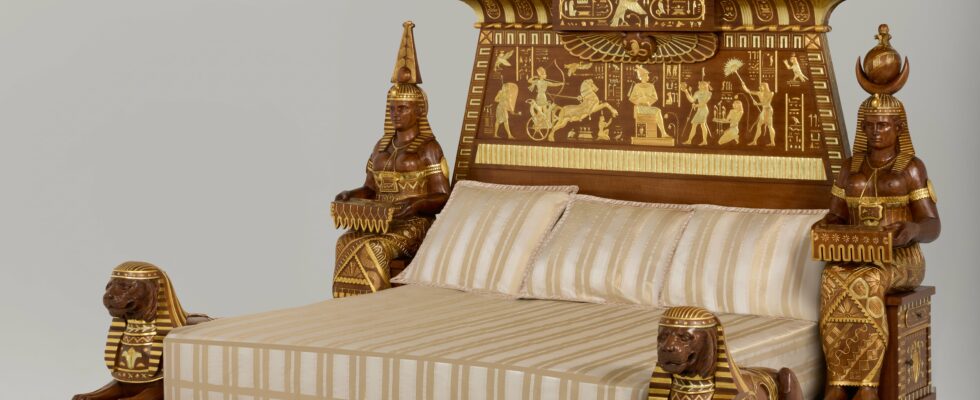By frequenting exhibitions and sales rooms, visitors easily see that when it comes to art, the modes of expression are very varied. Classic good taste, long promoted by institutions, now coexists with the most expressive, and sometimes the most aggressive, modernity, popular art, archeology or primitive arts. He also discovered a multitude of unusual and extravagant objects which had long remained in museum sheds and the stocks of antique dealers.
These works are gradually emerging from oblivion and attracting an ever-wider audience. The craze extends to contemporary artists, whose unusual approach is immediately recognizable. For its 2025 edition, which takes place from January 26 to February 2 in the Belgian capital, Brafa – Brussels Art Fair – is riding this trend, with the numerous exhibitors offering an anthology of works likely to appeal to the most varied tastes.
A Hollywood peplum bed
The fair’s organizing committee has, in this spirit, invited the Portuguese artist Joana Vasconcelos, known for her very original creations mixing steel, cement and crochet with multicolored wool. She will present two monumental sculptures there but galleries like La Patinoire royale will also offer fans works of more reasonable dimensions. The artist’s price is elastic, from 1,500 euros for small ceramics to more than 200,000 euros for his large sculptures.
Unusual works of art are not the exclusive domain of our century. 19th and 20th century furniture is full of creations, each more unique than the last. The cabinetmakers of the 19th century found their inspiration in all periods, the Middle Ages, the Renaissance, the Baroque but also in Antiquity. With the Egyptian campaign led by Bonaparte, Europe discovered the art of the pharaohs and artisans were inspired by it to create clocks, seats and tables. Some designers do not hesitate to create impressive furniture, with assumed eccentricity, like this bed presented by the Marc Maison gallery worthy of appearing in a Hollywood epic.
Gustavian furniture, less solemn than Louis XVI
In the 1950s and 1960s, pop, colorful furniture with round shapes responded to the desire for comfort and freedom. Quickly considered old-fashioned, it is now popular with younger generations who will certainly appreciate the creations of Poltronova editions, such as this large Safari sofa in the shape of waves with leopard print made in 1968 and whose reissues are sold for nearly 40,000 euros. It is presented by Maison Rapin.
The unusual is not just the eccentric, as long as we are interested in little-known artistic movements that are impossible to find in France. This is the case of Gustavian furniture, named after the King of Sweden Gustav III (1746-1792), which appeared around 1780 under his reign and remained in vogue for around thirty years. This furniture is a happy, less solemn mix of French Louis XVI and Empire styles, presented for its first participation by Hoffmans Antiques, a gallery from Stockholm.
Indian dolls from Arizona
For those who appreciate primitive arts, you have to leave Africa and look at Inuit art from the frozen lands of northern Canada and Alaska, brilliantly defended by the Flak gallery. You can acquire shamanic masks but also small figurines with oblong shapes, enigmatic features and a hieratic appearance, most often sculpted from walrus teeth.
The same gallery offers a remarkable selection of antique kachina dolls from the Hopi Indians of Arizona. Colorful, with varied shapes, they were offered to children to familiarize them with the masks and costumes used by shamans during invocation dances for rain and harvests. The price range for these Eskimo or Hopi works of art goes from a few thousand to several tens of thousands of euros for archaic Inuit sculptures from the beginning of the first millennium.
Unusual or unknown art thus crosses periods, continents and styles. Everyone, according to their tastes and means, can find the rare object there, before it becomes sought-after and therefore financially inaccessible.
